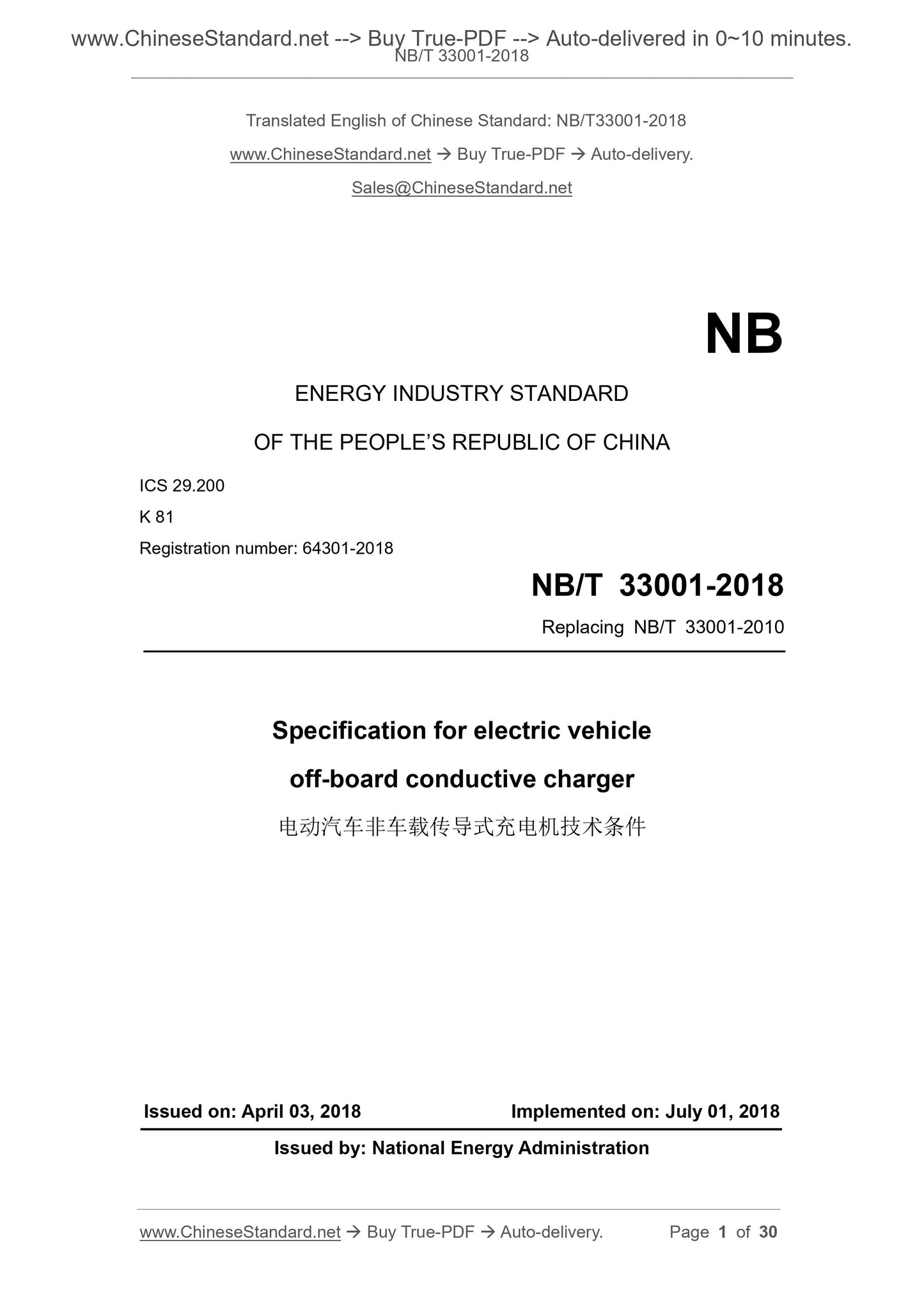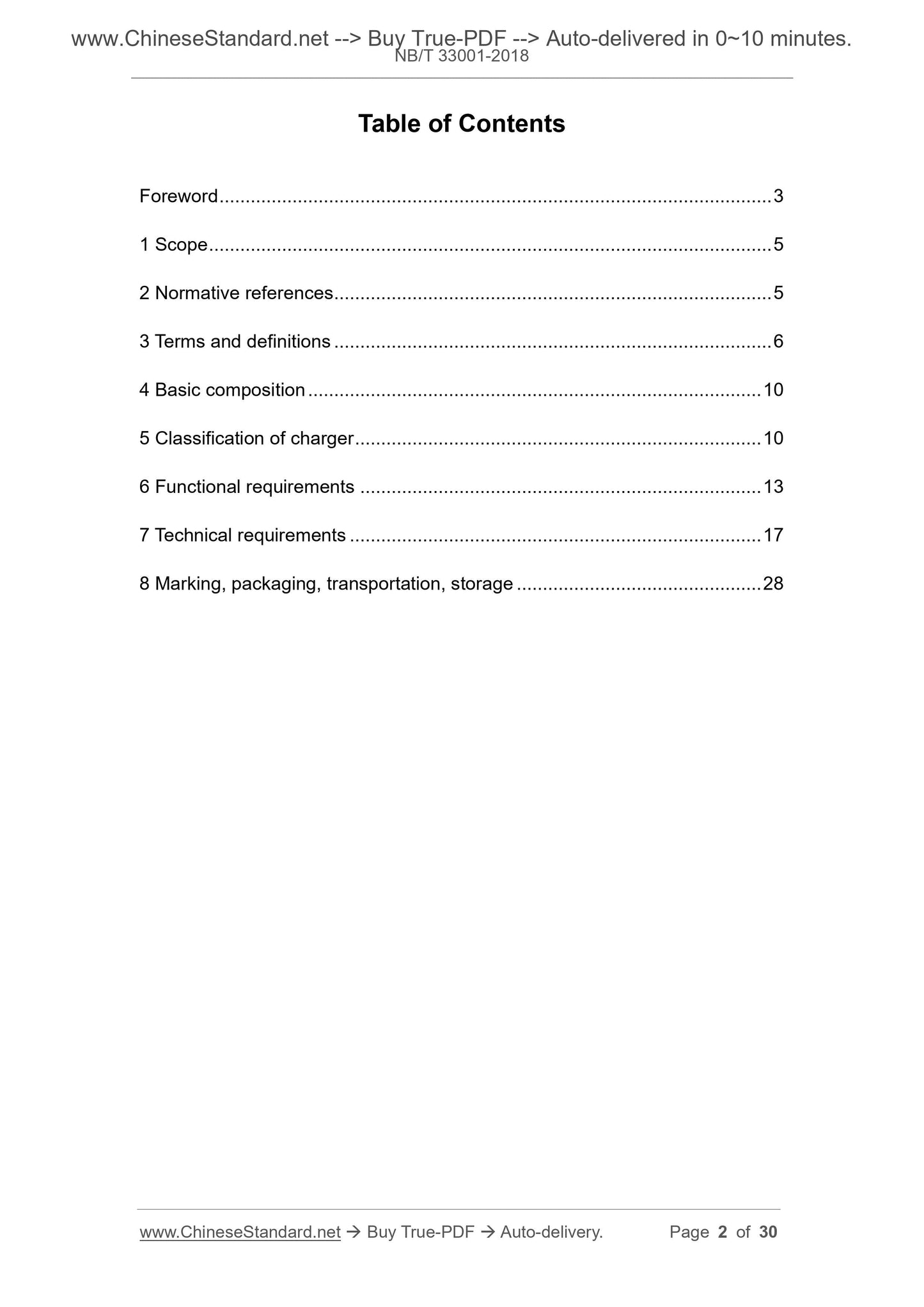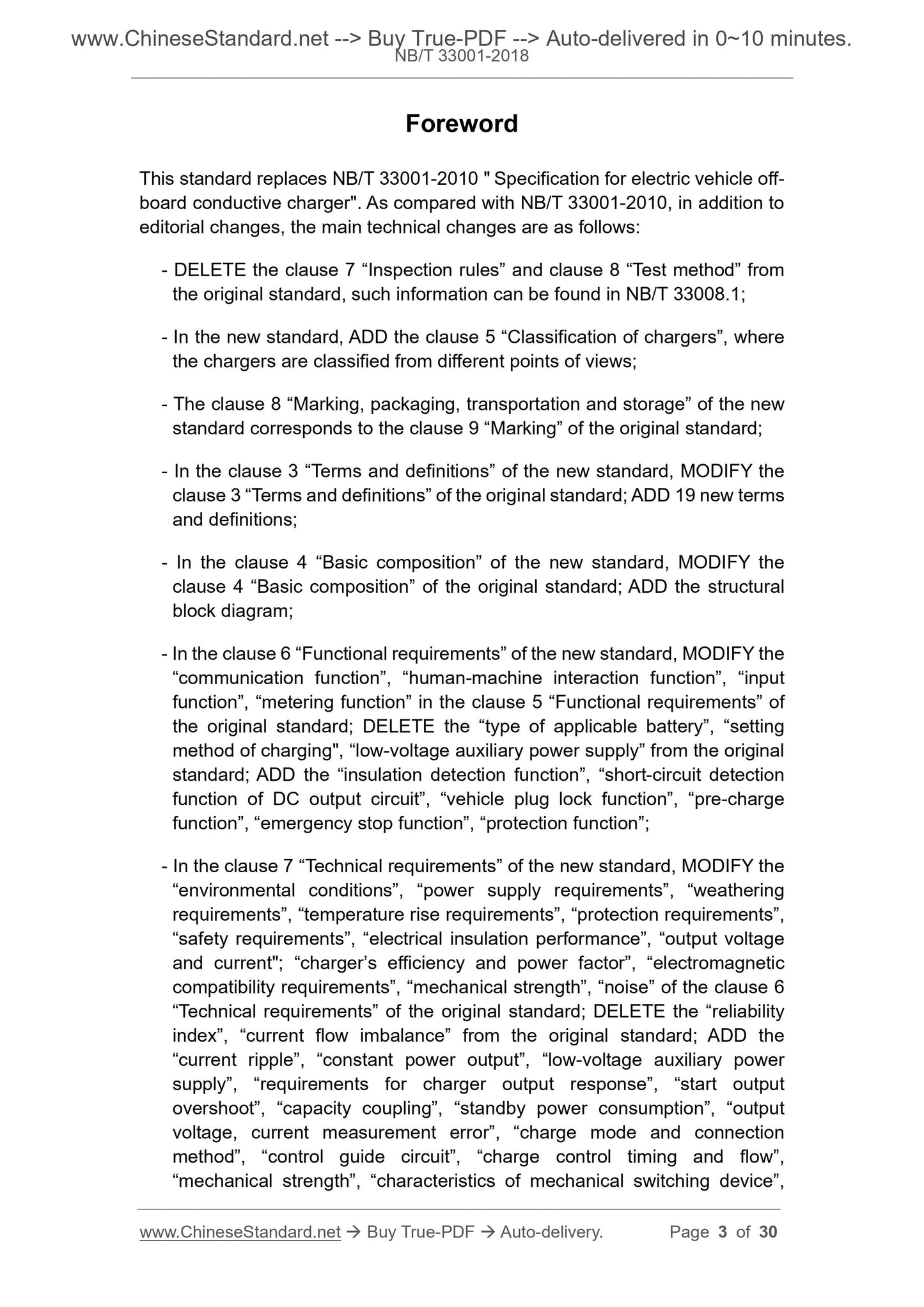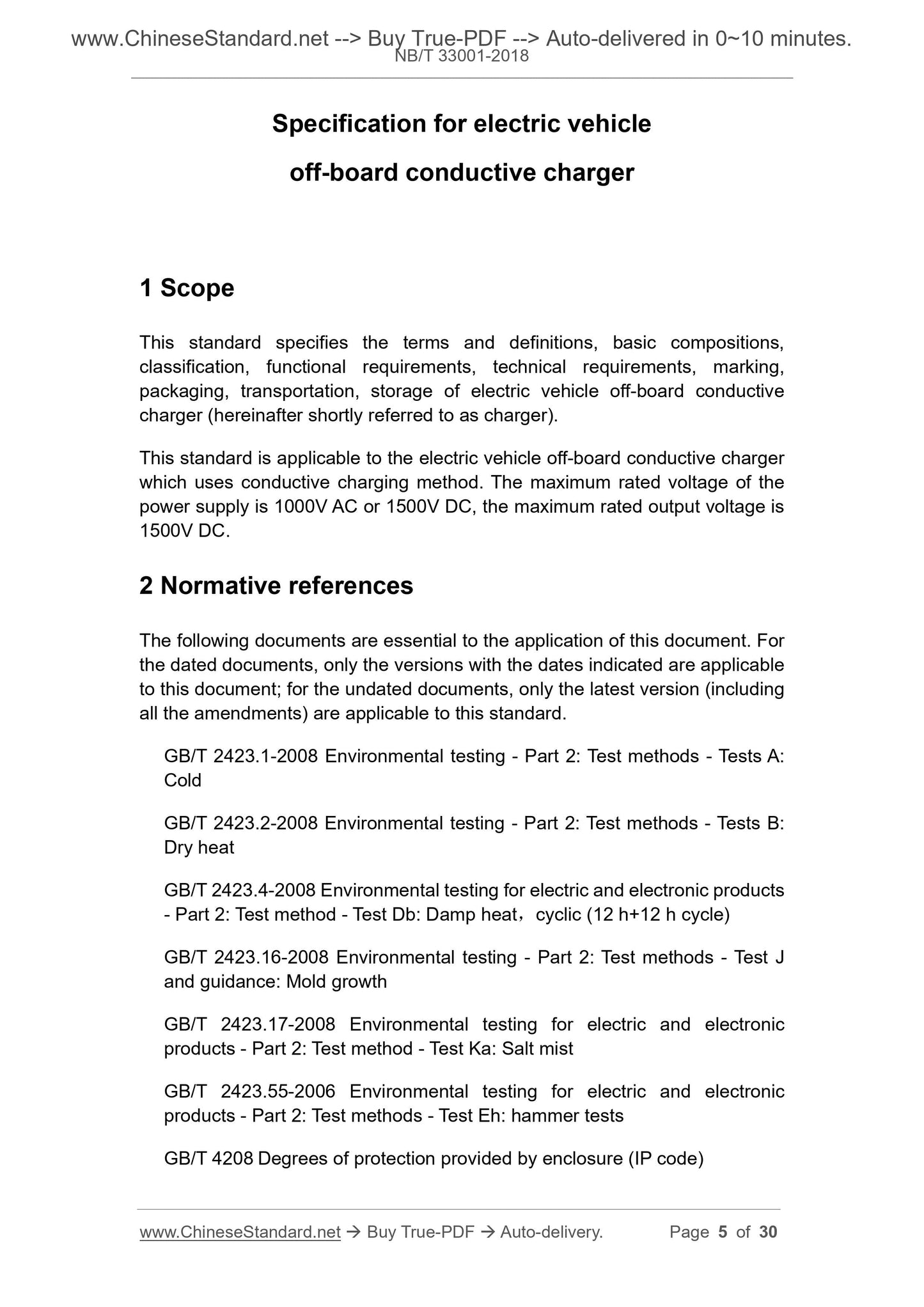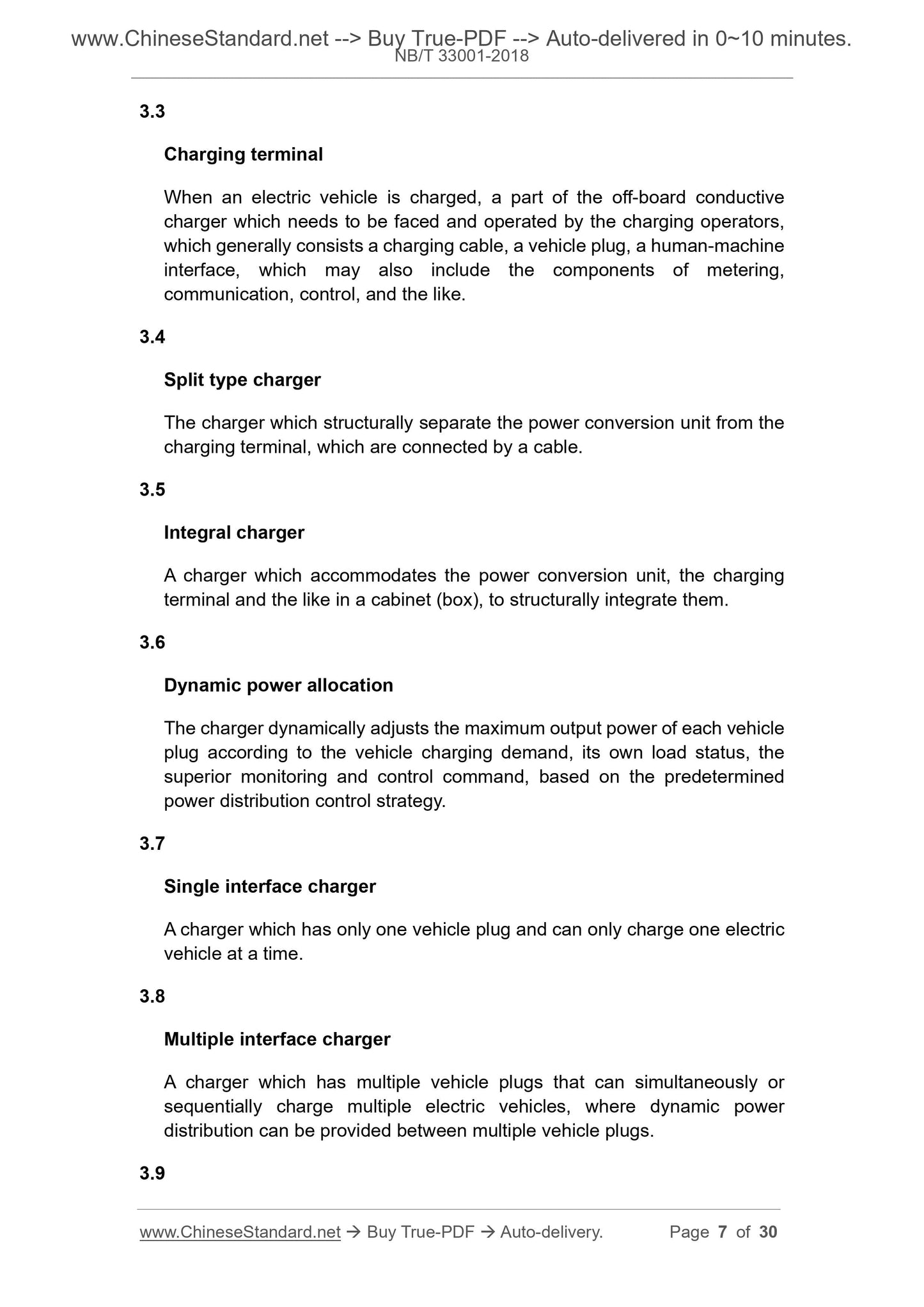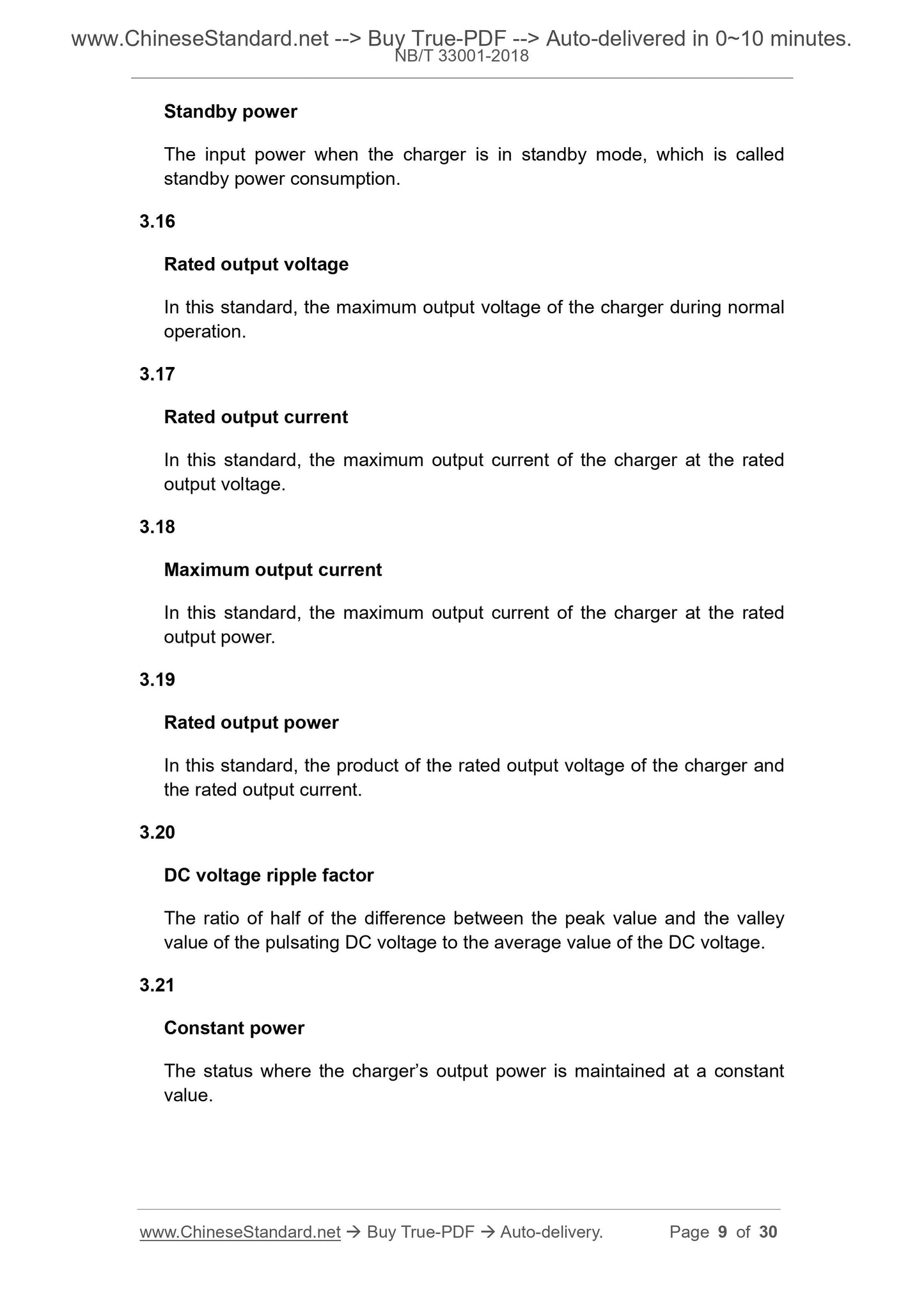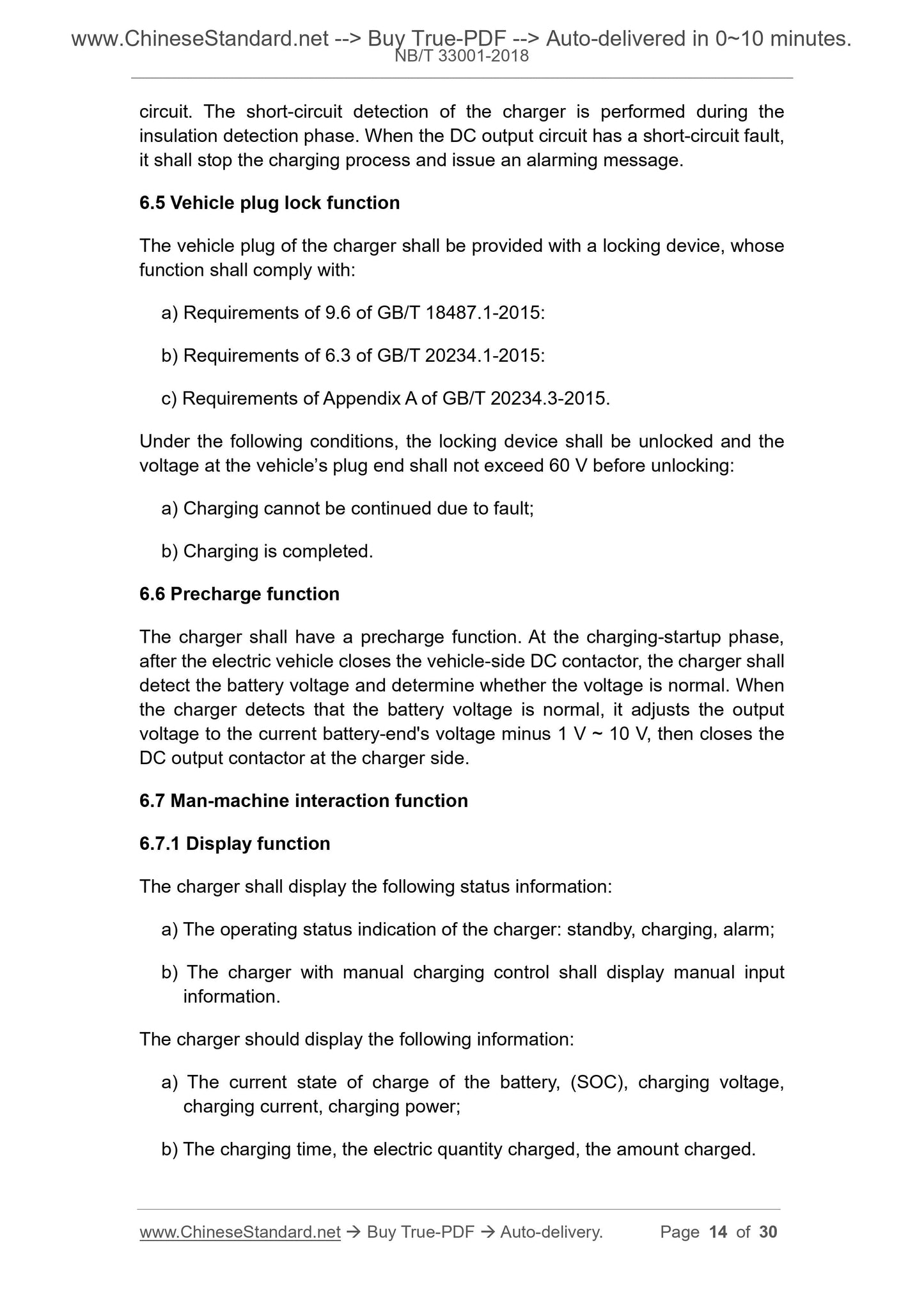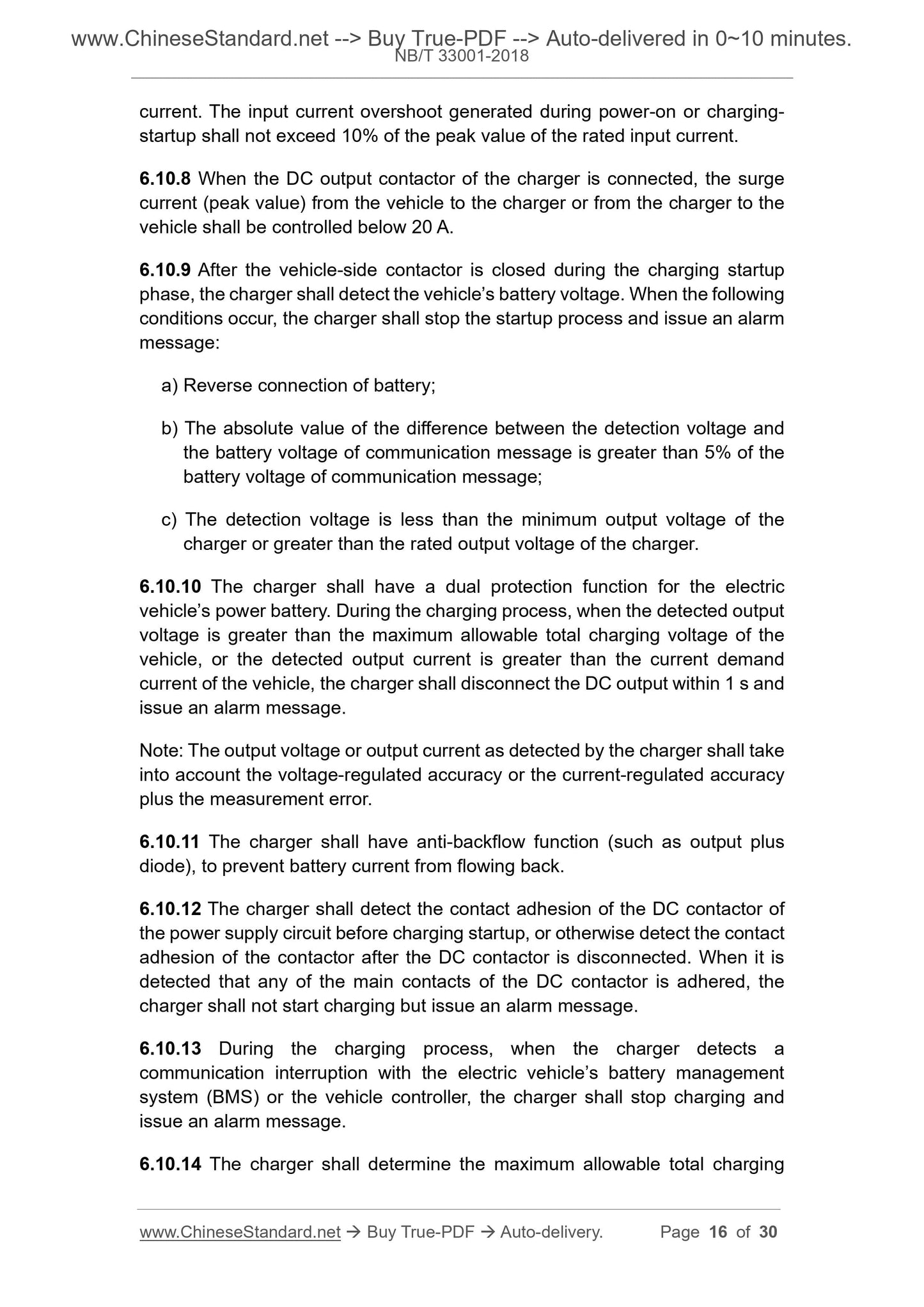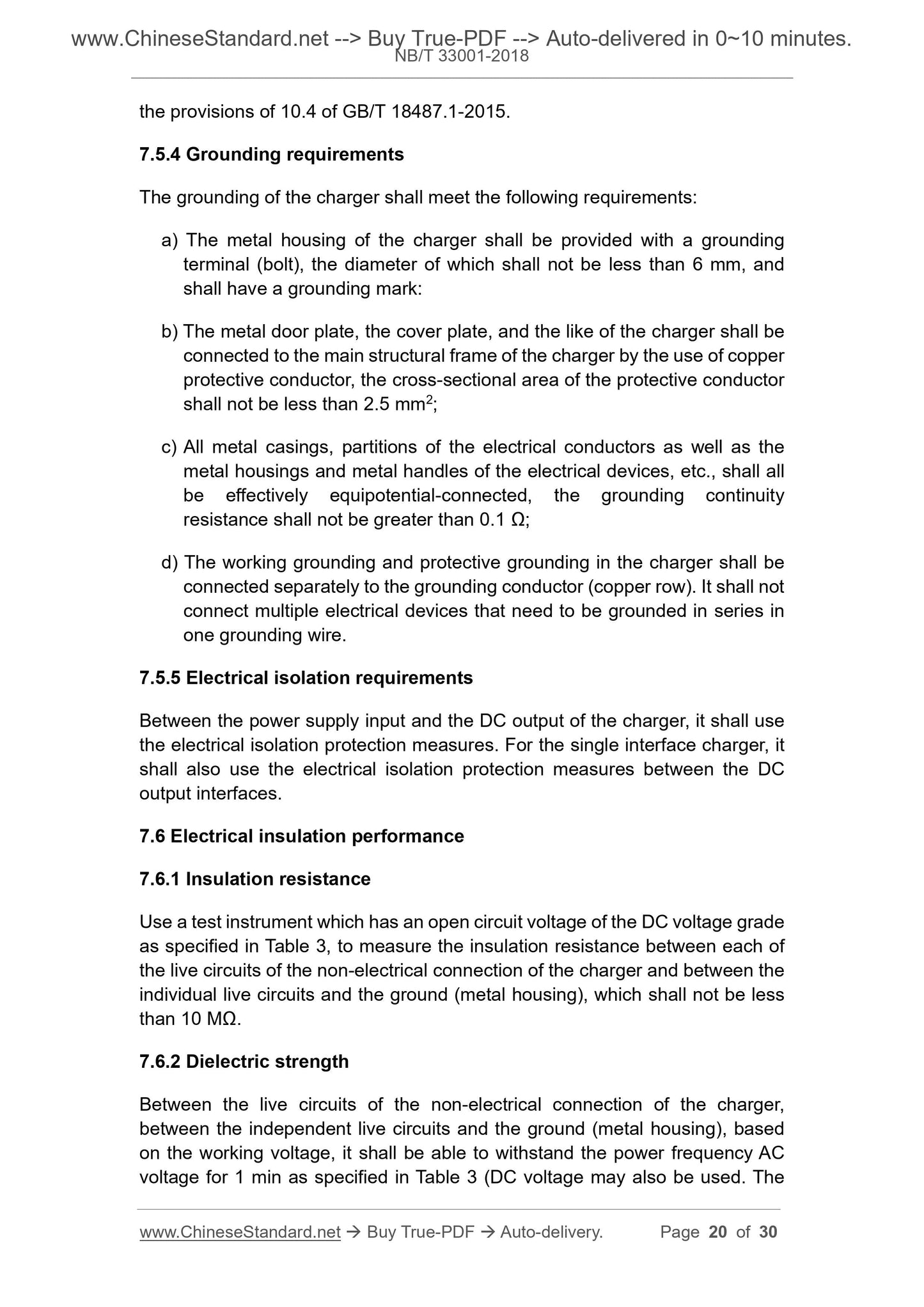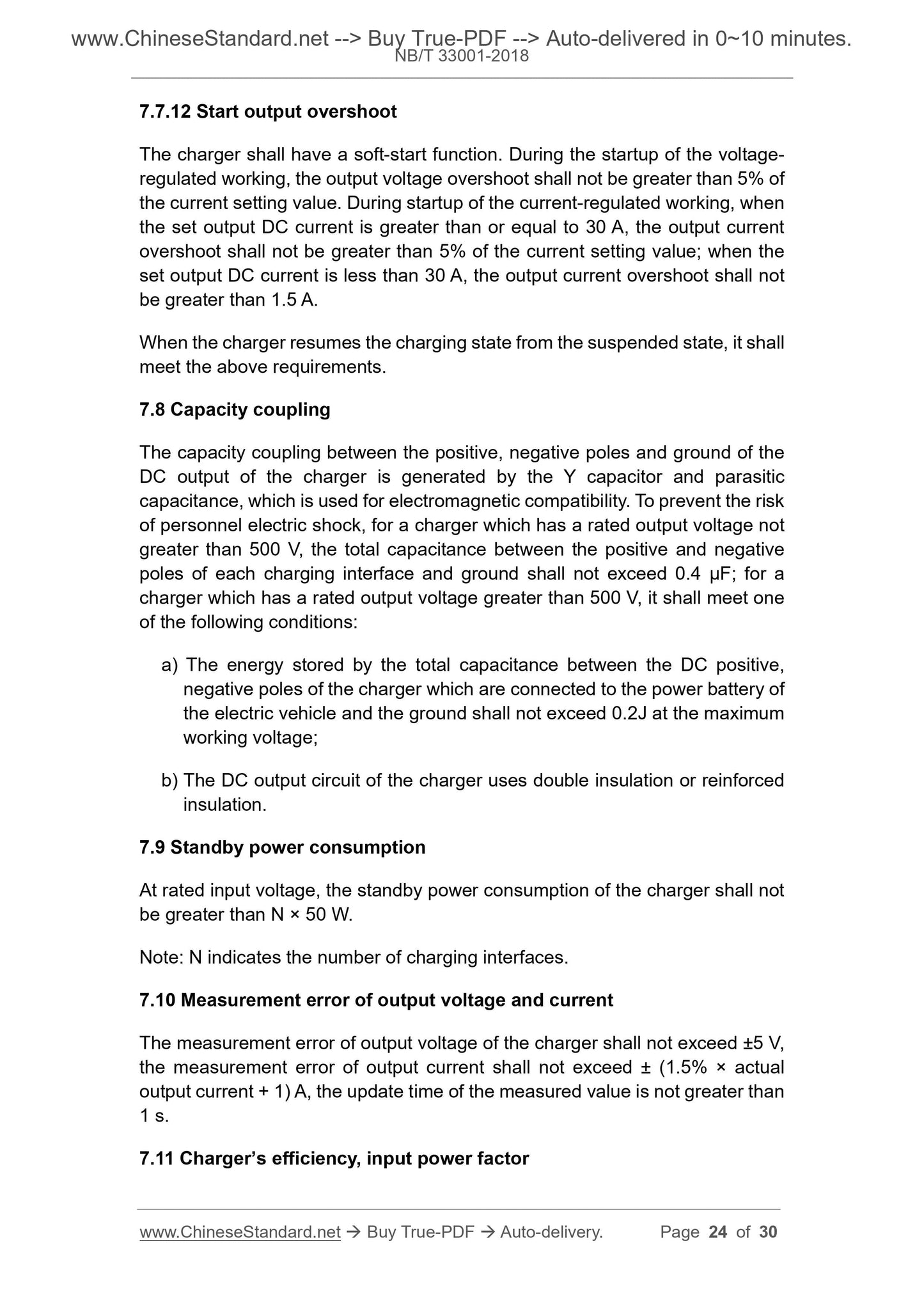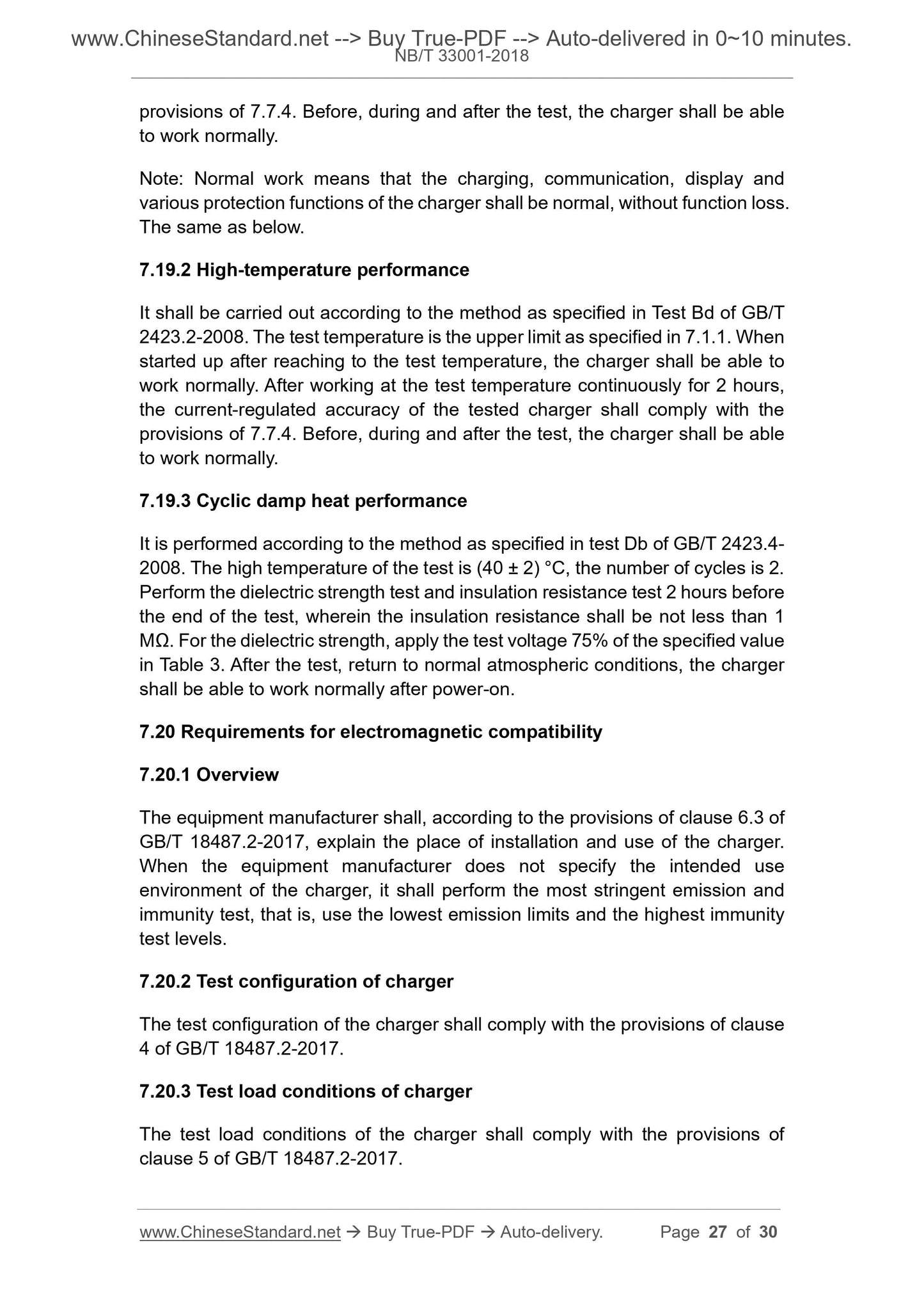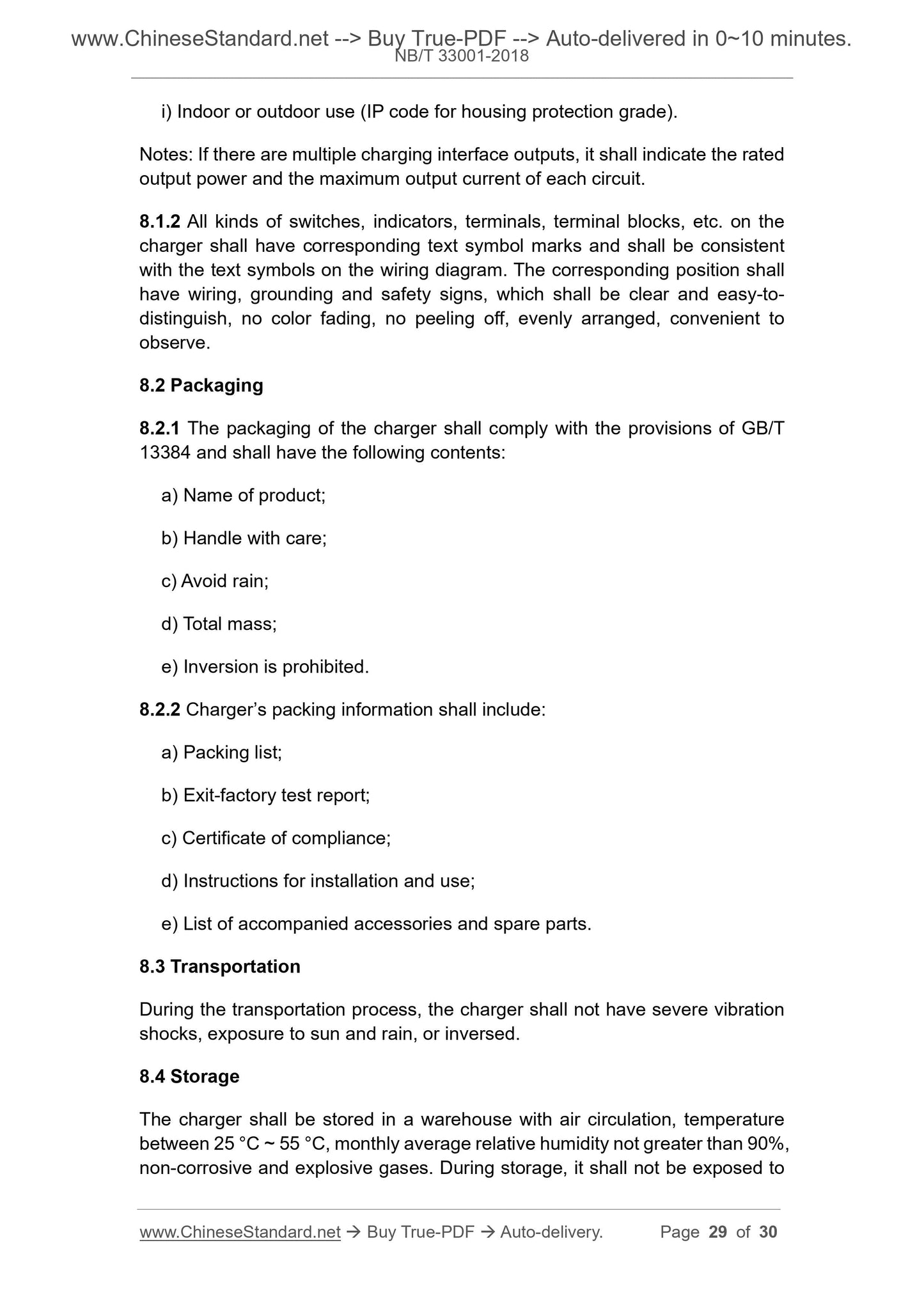1
/
of
12
PayPal, credit cards. Download editable-PDF and invoice in 1 second!
NB/T 33001-2018 English PDF (NB/T33001-2018)
NB/T 33001-2018 English PDF (NB/T33001-2018)
Regular price
$260.00 USD
Regular price
Sale price
$260.00 USD
Unit price
/
per
Shipping calculated at checkout.
Couldn't load pickup availability
Delivery: 3 seconds. Download true-PDF + Invoice.
Get QUOTATION in 1-minute: Click NB/T 33001-2018
Historical versions: NB/T 33001-2018
Preview True-PDF (Reload/Scroll if blank)
NB/T 33001-2018: Specification for electric vehicle off-board conductive charger
NB/T 33001-2018
NB
ENERGY INDUSTRY STANDARD
OF THE PEOPLE’S REPUBLIC OF CHINA
ICS 29.200
K 81
Registration number. 64301-2018
Replacing NB/T 33001-2010
Specification for electric vehicle
off-board conductive charger
ISSUED ON. APRIL 03, 2018
IMPLEMENTED ON. JULY 01, 2018
Issued by. National Energy Administration
Table of Contents
Foreword ... 3
1 Scope ... 5
2 Normative references ... 5
3 Terms and definitions ... 6
4 Basic composition ... 10
5 Classification of charger ... 10
6 Functional requirements ... 13
7 Technical requirements ... 17
8 Marking, packaging, transportation, storage ... 28
Foreword
This standard replaces NB/T 33001-2010 " Specification for electric vehicle off-
board conductive charger". As compared with NB/T 33001-2010, in addition to
editorial changes, the main technical changes are as follows.
- DELETE the clause 7 “Inspection rules” and clause 8 “Test method” from
the original standard, such information can be found in NB/T 33008.1;
- In the new standard, ADD the clause 5 “Classification of chargers”, where
the chargers are classified from different points of views;
- The clause 8 “Marking, packaging, transportation and storage” of the new
standard corresponds to the clause 9 “Marking” of the original standard;
- In the clause 3 “Terms and definitions” of the new standard, MODIFY the
clause 3 “Terms and definitions” of the original standard; ADD 19 new terms
and definitions;
- In the clause 4 “Basic composition” of the new standard, MODIFY the
clause 4 “Basic composition” of the original standard; ADD the structural
block diagram;
- In the clause 6 “Functional requirements” of the new standard, MODIFY the
“communication function”, “human-machine interaction function”, “input
function”, “metering function” in the clause 5 “Functional requirements” of
the original standard; DELETE the “type of applicable battery”, “setting
method of charging", “low-voltage auxiliary power supply” from the original
standard; ADD the “insulation detection function”, “short-circuit detection
function of DC output circuit”, “vehicle plug lock function”, “pre-charge
function”, “emergency stop function”, “protection function”;
- In the clause 7 “Technical requirements” of the new standard, MODIFY the
“environmental conditions”, “power supply requirements”, “weathering
requirements”, “temperature rise requirements”, “protection requirements”,
“safety requirements”, “electrical insulation performance”, “output voltage
and current"; “charger’s efficiency and power factor”, “electromagnetic
compatibility requirements”, “mechanical strength”, “noise” of the clause 6
“Technical requirements” of the original standard; DELETE the “reliability
index”, “current flow imbalance” from the original standard; ADD the
“current ripple”, “constant power output”, “low-voltage auxiliary power
supply”, “requirements for charger output response”, “start output
overshoot”, “capacity coupling”, “standby power consumption”, “output
voltage, current measurement error”, “charge mode and connection
method”, “control guide circuit”, “charge control timing and flow”,
“mechanical strength”, “characteristics of mechanical switching device”,
Specification for electric vehicle
off-board conductive charger
1 Scope
This standard specifies the terms and definitions, basic compositions,
classification, functional requirements, technical requirements, marking,
packaging, transportation, storage of electric vehicle off-board conductive
charger (hereinafter shortly referred to as charger).
This standard is applicable to the electric vehicle off-board conductive charger
which uses conductive charging method. The maximum rated voltage of the
power supply is 1000V AC or 1500V DC, the maximum rated output voltage is
1500V DC.
2 Normative references
The following documents are essential to the application of this document. For
the dated documents, only the versions with the dates indicated are applicable
to this document; for the undated documents, only the latest version (including
all the amendments) are applicable to this standard.
GB/T 2423.1-2008 Environmental testing - Part 2. Test methods - Tests A.
Cold
GB/T 2423.2-2008 Environmental testing - Part 2. Test methods - Tests B.
Dry heat
GB/T 2423.4-2008 Environmental testing for electric and electronic products
- Part 2. Test method - Test Db. Damp heat, cyclic (12 h+12 h cycle)
GB/T 2423.16-2008 Environmental testing - Part 2. Test methods - Test J
and guidance. Mold growth
GB/T 2423.17-2008 Environmental testing for electric and electronic
products - Part 2. Test method - Test Ka. Salt mist
GB/T 2423.55-2006 Environmental testing for electric and electronic
products - Part 2. Test methods - Test Eh. hammer tests
GB/T 4208 Degrees of protection provided by enclosure (IP code)
3.3
Charging terminal
When an electric vehicle is charged, a part of the off-board conductive
charger which needs to be faced and operated by the charging operators,
which generally consists a charging cable, a vehicle plug, a human-machine
interface, which may also include the components of metering,
communication, control, and the like.
3.4
Split type charger
The charger which structurally separate the power conversion unit from the
charging terminal, which are connected by a cable.
3.5
Integral charger
A charger which accommodates the power conversion unit, the charging
terminal and the like in a cabinet (box), to structurally integrate them.
3.6
Dynamic power allocation
The charger dynamically adjusts the maximum output power of each vehicle
plug according to the vehicle charging demand, its own load status, the
superior monitoring and control command, based on the predetermined
power distribution control strategy.
3.7
Single interface charger
A charger which has only one vehicle plug and can only charge one electric
vehicle at a time.
3.8
Multiple interface charger
A charger which has multiple vehicle plugs that can simultaneously or
sequentially charge multiple electric vehicles, where dynamic power
distribution can be provided between multiple vehicle plugs.
3.9
Standby power
The input power when the charger is in standby mode, which is called
standby power consumption.
3.16
Rated output voltage
In this standard, the maximum output voltage of the charger during normal
operation.
3.17
Rated output current
In this standard, the maximum output current of the charger at the rated
output voltage.
3.18
Maximum output current
In this standard, the maximum output current of the charger at the rated
output power.
3.19
Rated output power
In this standard, the product of the rated output voltage of the charger and
the rated output current.
3.20
DC voltage ripple factor
The ratio of half of the difference between the peak value and the valley
value of the pulsating DC voltage to the average value of the DC voltage.
3.21
Constant power
The status where the charger’s output power is maintained at a constant
value.
circuit. The short-circuit detection of the charger is performed during the
insulation detection phase. When the DC output circuit has a short-circuit fault,
it shall stop the charging process and issue an alarming message.
6.5 Vehicle plug lock function
The vehicle plug of the charger shall be provided with a...
Get QUOTATION in 1-minute: Click NB/T 33001-2018
Historical versions: NB/T 33001-2018
Preview True-PDF (Reload/Scroll if blank)
NB/T 33001-2018: Specification for electric vehicle off-board conductive charger
NB/T 33001-2018
NB
ENERGY INDUSTRY STANDARD
OF THE PEOPLE’S REPUBLIC OF CHINA
ICS 29.200
K 81
Registration number. 64301-2018
Replacing NB/T 33001-2010
Specification for electric vehicle
off-board conductive charger
ISSUED ON. APRIL 03, 2018
IMPLEMENTED ON. JULY 01, 2018
Issued by. National Energy Administration
Table of Contents
Foreword ... 3
1 Scope ... 5
2 Normative references ... 5
3 Terms and definitions ... 6
4 Basic composition ... 10
5 Classification of charger ... 10
6 Functional requirements ... 13
7 Technical requirements ... 17
8 Marking, packaging, transportation, storage ... 28
Foreword
This standard replaces NB/T 33001-2010 " Specification for electric vehicle off-
board conductive charger". As compared with NB/T 33001-2010, in addition to
editorial changes, the main technical changes are as follows.
- DELETE the clause 7 “Inspection rules” and clause 8 “Test method” from
the original standard, such information can be found in NB/T 33008.1;
- In the new standard, ADD the clause 5 “Classification of chargers”, where
the chargers are classified from different points of views;
- The clause 8 “Marking, packaging, transportation and storage” of the new
standard corresponds to the clause 9 “Marking” of the original standard;
- In the clause 3 “Terms and definitions” of the new standard, MODIFY the
clause 3 “Terms and definitions” of the original standard; ADD 19 new terms
and definitions;
- In the clause 4 “Basic composition” of the new standard, MODIFY the
clause 4 “Basic composition” of the original standard; ADD the structural
block diagram;
- In the clause 6 “Functional requirements” of the new standard, MODIFY the
“communication function”, “human-machine interaction function”, “input
function”, “metering function” in the clause 5 “Functional requirements” of
the original standard; DELETE the “type of applicable battery”, “setting
method of charging", “low-voltage auxiliary power supply” from the original
standard; ADD the “insulation detection function”, “short-circuit detection
function of DC output circuit”, “vehicle plug lock function”, “pre-charge
function”, “emergency stop function”, “protection function”;
- In the clause 7 “Technical requirements” of the new standard, MODIFY the
“environmental conditions”, “power supply requirements”, “weathering
requirements”, “temperature rise requirements”, “protection requirements”,
“safety requirements”, “electrical insulation performance”, “output voltage
and current"; “charger’s efficiency and power factor”, “electromagnetic
compatibility requirements”, “mechanical strength”, “noise” of the clause 6
“Technical requirements” of the original standard; DELETE the “reliability
index”, “current flow imbalance” from the original standard; ADD the
“current ripple”, “constant power output”, “low-voltage auxiliary power
supply”, “requirements for charger output response”, “start output
overshoot”, “capacity coupling”, “standby power consumption”, “output
voltage, current measurement error”, “charge mode and connection
method”, “control guide circuit”, “charge control timing and flow”,
“mechanical strength”, “characteristics of mechanical switching device”,
Specification for electric vehicle
off-board conductive charger
1 Scope
This standard specifies the terms and definitions, basic compositions,
classification, functional requirements, technical requirements, marking,
packaging, transportation, storage of electric vehicle off-board conductive
charger (hereinafter shortly referred to as charger).
This standard is applicable to the electric vehicle off-board conductive charger
which uses conductive charging method. The maximum rated voltage of the
power supply is 1000V AC or 1500V DC, the maximum rated output voltage is
1500V DC.
2 Normative references
The following documents are essential to the application of this document. For
the dated documents, only the versions with the dates indicated are applicable
to this document; for the undated documents, only the latest version (including
all the amendments) are applicable to this standard.
GB/T 2423.1-2008 Environmental testing - Part 2. Test methods - Tests A.
Cold
GB/T 2423.2-2008 Environmental testing - Part 2. Test methods - Tests B.
Dry heat
GB/T 2423.4-2008 Environmental testing for electric and electronic products
- Part 2. Test method - Test Db. Damp heat, cyclic (12 h+12 h cycle)
GB/T 2423.16-2008 Environmental testing - Part 2. Test methods - Test J
and guidance. Mold growth
GB/T 2423.17-2008 Environmental testing for electric and electronic
products - Part 2. Test method - Test Ka. Salt mist
GB/T 2423.55-2006 Environmental testing for electric and electronic
products - Part 2. Test methods - Test Eh. hammer tests
GB/T 4208 Degrees of protection provided by enclosure (IP code)
3.3
Charging terminal
When an electric vehicle is charged, a part of the off-board conductive
charger which needs to be faced and operated by the charging operators,
which generally consists a charging cable, a vehicle plug, a human-machine
interface, which may also include the components of metering,
communication, control, and the like.
3.4
Split type charger
The charger which structurally separate the power conversion unit from the
charging terminal, which are connected by a cable.
3.5
Integral charger
A charger which accommodates the power conversion unit, the charging
terminal and the like in a cabinet (box), to structurally integrate them.
3.6
Dynamic power allocation
The charger dynamically adjusts the maximum output power of each vehicle
plug according to the vehicle charging demand, its own load status, the
superior monitoring and control command, based on the predetermined
power distribution control strategy.
3.7
Single interface charger
A charger which has only one vehicle plug and can only charge one electric
vehicle at a time.
3.8
Multiple interface charger
A charger which has multiple vehicle plugs that can simultaneously or
sequentially charge multiple electric vehicles, where dynamic power
distribution can be provided between multiple vehicle plugs.
3.9
Standby power
The input power when the charger is in standby mode, which is called
standby power consumption.
3.16
Rated output voltage
In this standard, the maximum output voltage of the charger during normal
operation.
3.17
Rated output current
In this standard, the maximum output current of the charger at the rated
output voltage.
3.18
Maximum output current
In this standard, the maximum output current of the charger at the rated
output power.
3.19
Rated output power
In this standard, the product of the rated output voltage of the charger and
the rated output current.
3.20
DC voltage ripple factor
The ratio of half of the difference between the peak value and the valley
value of the pulsating DC voltage to the average value of the DC voltage.
3.21
Constant power
The status where the charger’s output power is maintained at a constant
value.
circuit. The short-circuit detection of the charger is performed during the
insulation detection phase. When the DC output circuit has a short-circuit fault,
it shall stop the charging process and issue an alarming message.
6.5 Vehicle plug lock function
The vehicle plug of the charger shall be provided with a...
Share
